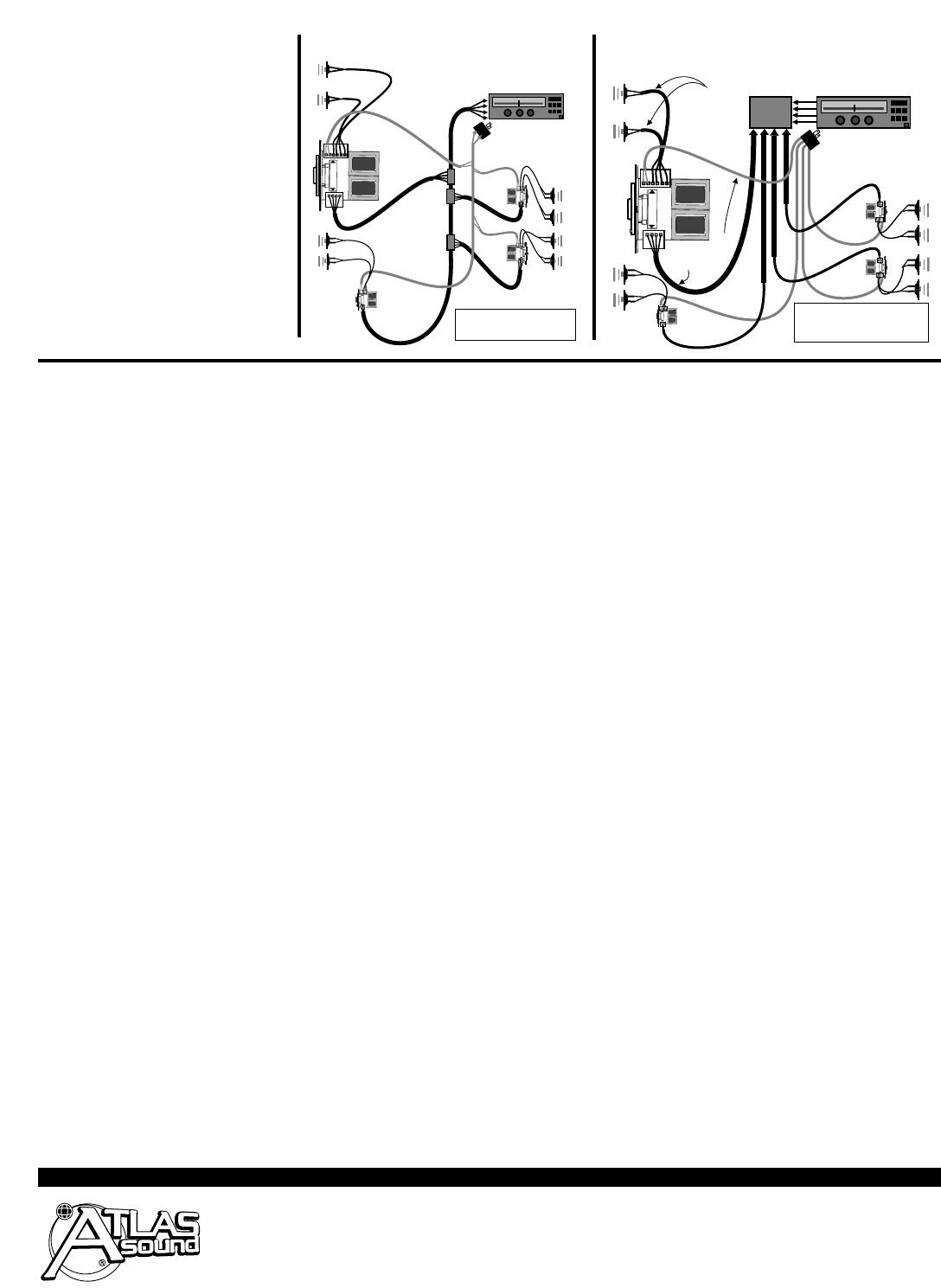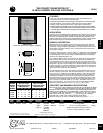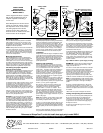
Specifications subject to change without notice
© 2001 Atlas Sound LP Printed in U.S.A. 000801 PN 389525 SL4-1571
1601 JACK MCKAY BLVD. / ENNIS, TEXAS 75119 U.S.A. / TELEPHONE: (800) 876-3333 / FAX (800) 765-3435
Mounting Location:
Volume controls should be placed in accessible
wall locations that are close to entryways, exits,
light switches, or telephones. They may also be
ganged with other low voltage* controls such as
keypads or infrared repeaters.
*Note: WhisperTouch should not be mounted into
the same electrical box used for a 110-volt device
—even if the box says it is partitioned for this pur-
pose. Speaker wires may pick up electrical noise
which will be transmitted as a buzzing or popping
sound to the loudspeakers.
Mounting Requirements:
Switched WhisperTouch units are slightly taller,
wider, and deeper than most volume controls and
requires a 20 cu in. E.O. box with a minimum
inside depth of 2.75" and a minimum inside height
of 2.985". Recommended boxes for new construc-
tion include: Carlon PVC switch box #B-120A, and
RACO PVC outlet box. For retrofit applications,
CADDY drywall trim ring #MPLS may be used.
Calculating the proper Impedance
settings for the system:
WhisperTouch is an impedance-matching stereo vol-
ume control that allows multiple loudspeaker pairs
and volume controls to be connected, in parallel,
without the additional cost of a separate impedance-
matching device. For flexibility in system design,
WhisperTouch has three impedance matching capa-
bilities: 2X, 4X and 8X, as well as a 1X non-imped-
ance matching setting that allows the unit to be used
as a standard 8 Ohm volume control
To determine which setting should be used (1X, 2X,
4X and 8X) you will need to know the number of
loudspeaker pairs, the loudspeaker impedance,
and the load capability (output impedance) of the
amplifier. Most amplifiers will handle a load down to
four or two ohms with some going as low as 1 ohm.
Using the chart on page one; cross reference the
number of loudspeaker pairs to the amplifier imped-
ance. Notice that the 4X jumper setting will allow
twice as many loudspeaker pairs.
Example: If you have 8 pairs of 8-ohm loudspeak-
ers and an amplifier capable of handling a 4 ohm
load you must set WhisperTouch at the 4X setting for
the amplifier to drive all 8 pairs of speakers at full vol-
ume. Note that the 2X setting allows only 4 pairs of
8-ohm loudspeakers to operate on a 4 ohm load. If
however, you could select an amplifier with a 2 ohm
output impedance, the same 8 loudspeakers could
operate on a 2 ohm load (at the 2X setting) or 16
loudspeaker pairs (at the 4X setting). Whenever pos-
sible, the lowest jumper setting for a given amplifier
should be selected.
Changing Impedance Jumpers:
Once the proper impedance setting is determined,
locate the impedance jumpers (black plastic mod-
ules) on the back side of the circuit board. One
jumper is for the right channel, the other for the left.
Next, locate the 1X, 2X, 4X and 8X settings on the
circuit board for each channel. If the settings are
correct, continue to the next step. If the settings
need to change, simply slide the jumper modules
off and reinstall them on to the correct two pins.
Limitations:
WhisperTouch limits the degree of impedance match-
ing to eight times so that music quality and overall
performance is not sacrificed. We do not recommend
that any quality, multi-room music system be con-
nected to a device which provides 16X impedance
matching as it may limit the amplifier’s power and
system performance.
Prewiring and Installation:
A.Mount the outlet box or plaster ring in the wall
(see mounting requirements). Each room’s wiring
can be individually run back to the amplifier (home
run) or connected from one room to the other
(daisy chain). The daisy chain wiring method con-
nects one set of speakers with volume control in
parallel to the next, using connection block or
crimp connectors in between. This method has the
advantage of requiring less wiring for the system
rough-in, but allows for little or no system upgrad-
ing for future applications.
With either method, be sure to mark the cable con-
nected to the amplifier as [INPUT] and write down
the color codes you have designated for the left
channel, right channel, positive, and negative leads
and the (+) and (-) power supply leads.
B.If using the "Home Run" wiring method, each
rooms speaker/volume control wiring should be
individually run back to the Main Equipment
Location "MEL" in a "home-run" fashion. Run a
total of six conductors of speaker cable from the
amplifier location to each room's volume control
box. Four conductors are speaker outputs and the
two additional conductors connect to the 12VDC
power supply. Power Supply conductors may be as
small as 22 gauge.
Note: Many building and fire codes require cable
to be CL-2, CL-3, or FT4 rated. Check with your
local building inspector before prewiring.
C.Next, run a two-conductor speaker cable from the
outlet box to the corresponding left and right speak-
ers. Mark each cable [LEFT] and [RIGHT] and deter-
mine the polarity of each channel (positive and neg-
ative).
D.Cut the cable accordingly, allowing enough cable to
hang outside the outlet box, to properly connect the
volume control. Tuck the cable back into the outlet
box to prevent damage during drywall installation.
E. If desired, the terminal block may be removed
from the volume control to more easily accomodate
wiring. Strip 1/4" of insulation off each conductor
and insert the wires into the terminal block. Tighten
the terminal block screws frimly and re-install the
terminal block onto the pins.
F.The WhisperTouch DWS-8 Series electronic con-
trol requires a 12VDC power supply plugged into
the “SWITCHED” outlet of the stereo system
receiver, preamplifier, or integrated amplifier. The
power supply rating is determined by the quantity
of DWS-8 units connected to the system. The for-
mula is a follows:
Qty of DWS-8 x 100mA = power supply mA rating.
EXAMPLE: Asystem with nine DWS-8 controls
would require a 900 mA (approximately 1 amp)
supply such as PS12-10.
G.Tuck the excess cable from inside the outlet box
back out into the wall or fold wires carefully while
inserting the volume control into the outlet box.
Position the volume control so that the front bracket
lines up with the mounting holes on the box. In
some cases, WhisperTouch may be a tight fit
requiring it to be inserted on the right side of the
outlet box and then slid left into the center position.
Note: In retrofit applications, metal extension plates
and non-recommended outlet boxes may require field
modification to accept the units’higher and deeper
profile.
H.Secure unit with supplied screws. We recom-
mend loosening the screws 1/4 turn to allow 1/4"
movement side-to-side and front-to-back. This will
allow the face plate to fit flush when the cover plate
is installed.
I.Mount the cover plate and tighten the screws.
Testing and operating the on/off feature:
A.Turn on the receiver that powers WhisperTouch.
B.The red indicator light on the WhisperTouch
should turn on, but music will not be playing.
C.Press the On/Off button once. The green indica-
tor light will turn on and music will begin playing.
D.Adjust the volume.
E.Press the On/Off button again to turn off the
music in that room.
Stereo Amplifier / Receiver
capable of handling a 4-ohm load
A
M
P SUPPLY
CONTROL
WIRE
L-
L+
R+
R-
12 VDC Power Supply
(Atlas Sound
PS-12M or PS12-10)
connects to Receiver's
"Switched" AC Outlet
Connect additional volume controls
if desired. Confirm maximum quantity
by referencing the impedance
chart on front side.
"Daisy Chain"
Wiring
*References to WhisperTouch
®
on this this install sheet apply only to model DWS-8
These diagrams illustrate a system
with 8-ohm loudspeakers and an
amplifier capable of handling a
4-ohm load.
Each WhisperTouch volume control
jumper is at the 2X setting (refer to
the impedance chart on front side).
The wiring depicts how volume
controls can be daisy chained or
wired in home run fashion from each
volume control to the amplifier.
INSTALLATION
INSTRUCTIONS
FOR WHISPERTOUCH
MODELS DWS-8
"MEL" Main Equipment Location
Connector
Block
A
M
P
SU
PPLY
L-
L+
R+
R-
Typ: 18-gauge Stranded
Twisted Pair Wiring
Stereo Amplifier / Receiver
capable of handling a 4-ohm load
12 VDC Power Supply
(Atlas Sound
PS-12M or PS12-10)
Connects to Receiver's
"Switched" AC Outlet
Connect additional volume controls
if desired. Confirm maximum quantity
by referencing the impedance
chart on front side.
CONTROL
WIRE
Typ: 18-gauge Stranded
Twisted Pair Wiring
"Home Run"
Wiring




